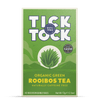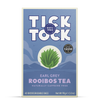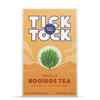
Rooibos, or 'Red Bush' tea, is a naturally caffeine-free tea that grows only in South Africa's Cedarberg mountains. While traditional black and green teas are made from the leaves of the Camellia Sinensis, rooibos is made from Aspalathus Linearis, a shrub unique to this protected World Heritage site.
Part of the Cape’s majestic floral kingdom, the Cedarberg is a pristine wilderness with breath-taking rock formations and huge open skies, some three hours north of Cape Town. This area is home to over 5000 different plant species, including rooibos which is part of the indigenous fynbos family. It is the unique combination of hot summers, cool winters, and well-drained sandy soil that allows rooibos to flourish only here, and nowhere else on earth.
Each summer, between January and March, the rooibos plants are harvested by hand using sickles. The soft needle-like leaves are taken in hessian bags to the tea making areas where they are chopped, bruised and dampened before being laid out to cure under the hot South African sun. The tea maker knows when the tea is ready by the arrival of honey bees, attracted by the deliciously sweet aroma of the dried rooibos.

GRANDFATHER BENJAMIN
This technique of making rooibos tea was pioneered over a century ago by our Grandfather Benjamin Ginsberg. A young man from a Moscow tea merchant family, he arrived in the Cedarberg in 1903 and became fascinated by the potential of the wild plant.
After a series of experiments, he perfected the practice of bruising and oxidising the wild plant using techniques similar to that of traditional Chinese oolong and Keemun tea making. Over 100 years later, we still use Grandfather Benjamin's techniques to make our rooibos tea.
'ROY-BOSS' TEA
Rooibos, pronounced ‘roy-boss’, is an Afrikaans word meaning ‘red bush’. However, confusingly the leaves of the rooibos plant are actually green. It is the process of oxidation that turns them that characteristic deep dark red – the same happens when you take a bite out of an apple.
'Green rooibos', as the name suggests, is rooibos where the oxidising process has been cut short so that the leaves keep their fresh green colour, giving a lighter, more delicate brew than ‘red rooibos’. The same is true for ordinary green and black tea; green leaves are oxidised to make black tea, and if oxidation is stopped they make green tea.
NATURALLY CAFFEINE FREE
Traditional black and green teas are made from the Camellia bush which contains caffeine. However, the rooibos plant (part of the pea and bean family) is naturally caffeine-free.

The stimulant effects of caffeine can last for between 5-6 hours. Therefore, if you struggle with insomnia or general anxiety, try sticking to caffeine-free tea such as rooibos or herbal tea, especially after midday. Long known for its gently hydrating and relaxing properties, rooibos has been used to help soothe little ones in its native South Africa for generations.
BENEFITS OF ROOIBOS TEA
Rooibos has been named one of the world's Top 50 Superfoods by Time Magazine and scientific research increasingly testifies to the multiple health benefits – mental, emotional and physical. In South Africa, it’s properties have been known and loved for generations where it is believed to be a relaxant and is often given to children with colic.
Rooibos is naturally caffeine-free of course, but it also has very low tannins (which interfere with iron absorption) and therefore no bitterness. It is calorie-free and sugar-free, and contains a range of antioxidant and anti-inflammatory compounds, known as polyphenols. Increasing evidence points to the positive role high levels of antioxidants and other compounds may have with regards to heart disease, diabetes and digestion. Some studies also link rooibos to weight loss and skin health, and the research into this magical tea is ongoing.

WHAT DOES ROOIBOS TEA TASTE LIKE?
Rooibos is smooth and full-bodied with an earthy sweetness and malted honeyed notes. Many people drink rooibos tea daily as an alternative to black tea as it has enough body to be drunk with milk. However, as it has no bitterness you can also drink it just as it, or with honey or lemon. You can make it whatever strength you like, leave it the bag as long as you like, and some even use two teabags for extra depth of flavour.
It also makes a great ice tea – the perfect alcohol-free drink for summertime. Simply brew a rooibos teabag in boiling water, and once the liquid is cool, place in the fridge adding a slice of lemon and mint to taste. At Tick Tock, we've created a delicious range of rooibos teas using all-natural ingredients, so there are lots of options to drink throughout the day. You can explore and shop our range of rooibos teas here.

[Reviewed and updated February 2024]





